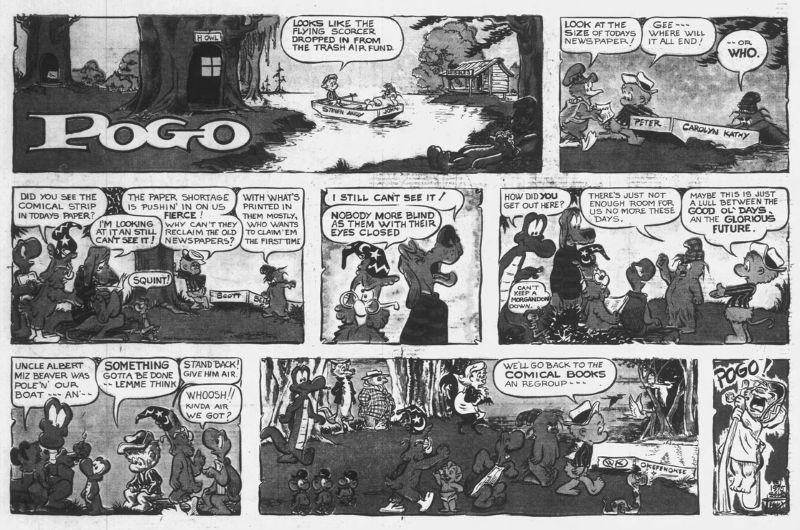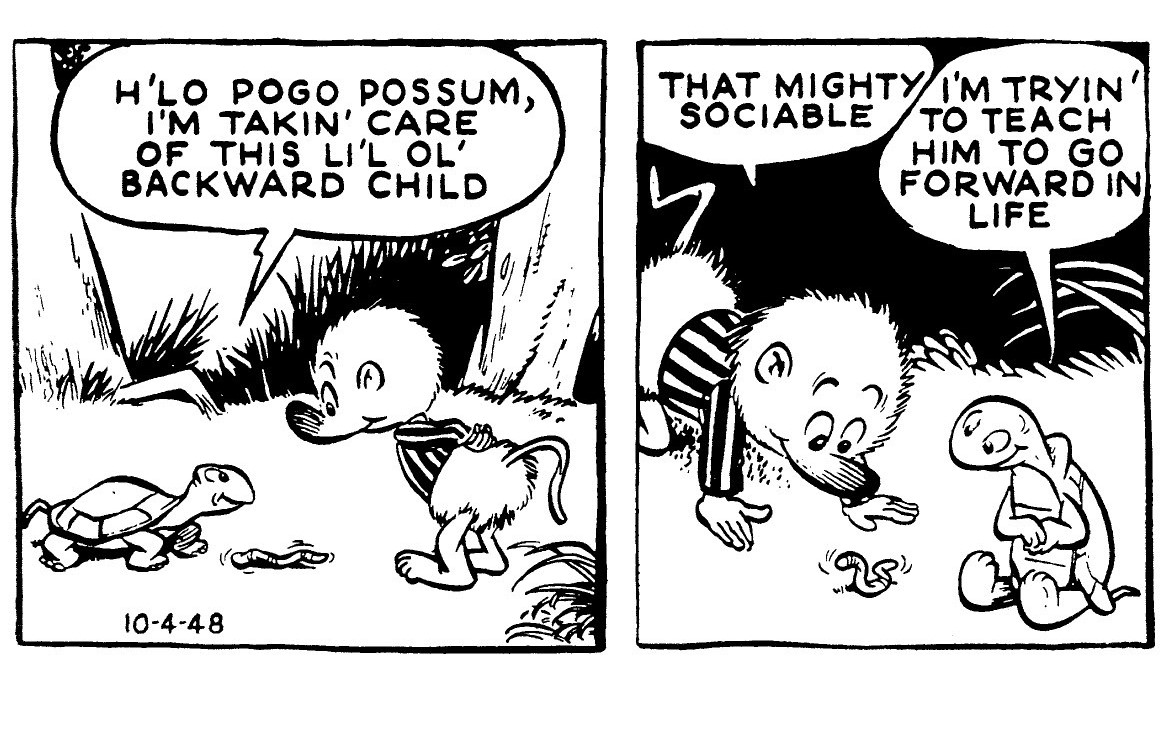Eighty-one years ago Walt Kelly introduced the world to Pogo Possum in a comic book.
For the next five years Pogo and Albert the Alligator appeared in those Animal Comics and in a couple Four-Color specials. Then in late 1947 Pogo and friends entered into a kind of limbo. Walt Kelly continued contributing to The Brownies and Mother Goose comic books, but Pogo went missing.
In early Summer of 1948 Walt Kelly went on staff at the nascent New York Star, a liberal newspaper. It took all of three months and a week for Walt Kelly to bring back his Pogo, not as a comic book but as a newspaper comic strip.

Pogo’s first newspaper comic strip was on October 4, 1948 in The New York Star, 75 years ago today.
That October 6th strip above may hold a clue as to why it took the better part of a year for Pogo to reappear. Animal Comics #30, cover dated December 1947/January 1948 (and released around late October/early November, 1947), shows the contents, including Pogo, were copyrighted by Oskar Lebeck. The Star Pogo is now copyright Walt Kelly. Was working out that detail the reason Pogo went on hiatus?
Anyway … Pogo ran weekdays in The Star until the paper folded on January 28, 1949.
The dream of most every cartoonist in those days was to get a successful syndicated comic strip, and that was Walt Kelly’s goal too. With a four month run to show he has the wits and artistic ability and the fortitude to do a daily strip it didn’t take a lot of arm twisting to convince Robert Hall of the Post-Hall Syndicate to take on Pogo. And so, four months after his last appearance in The Star, Pogo began appearing in newspapers around the country on May 16, 1948, with a bit of deja vu for readers who had read the Star strips:
In an appreciation and history of Pogo and Walt Kelly R. C. Harvey said:
Born in a comic book, Pogo (a possum by trade) outgrew the form (which, at the time, was a brand of juvenile literature) and graduated into the adult world, newspaper syndication, where he appeared in what became the greatest comic strip of the century. In Walt Kelly’s Pogo, the comic strip achieved the most of which the medium is capable. Comics can be high art in the right hands. And for over twenty years, Walt Kelly’s were the right hands.
In Pogo, the art form of the comic strip was raised to its zenith. If we accept the definition of comic strip art as a narrative of words and pictures, both verbal and visual, in which neither words nor pictures are quite satisfactory alone without the other, then we must say that Kelly welded the verbal and visual elements together into a comic chorus so unified, so mutually dependent, that it crystalized forever the very essence of the art.
Although the masterful Walt Kelly wouldn’t last as long, Pogo ran until July 29, 1975:

Pogo © OGPI




The truly amazing part of Kelly’s dream is that he was able to get that syndication contract with Post-Hall strictly as a distribution agreement, and was able to maintain ownership of the copyright for himself (just as he had at the defunct NY Star). This gave Kelly a degree of control over his strip that few other cartoonists have ever had. Decades later, Watterson managed it as well, but it cost him a nasty five-year battle with his syndicate, and may have been a partial reason for his premature retirement.
This article about Pogo was a delight to read. I loved the strip; from its very beginning in the early 1950’s I was hooked. I have two Pogo paperback books from that era: 1952’s ‘I Go Pogo” (which I had purchased for myself) and 1954’s “Potluck Pogo” (which I had given my dad for Christmas that year; he kept it all the following years; when he died in 1985, Mom said I should have the book as my own). These are treasures I have read several times over the following years … and they still make me laugh. Pogo simply does not age nor go out of style.
MORE!!!
In 25 years we’ll celebrate the centennial of the comic strip. Stick around.
In the early 1950s, Walt Kelly, for some reason unknown or forgotten, visited Jesuit High in New Orleans, my school, met with members of the school paper, did some rough sketches of Pogo and Alfred and created and donated a printer-ready pen-and-ink character based on the school’s blue jay mascot that looked like it could have just flown from a Pogo panel. While I was there, it was used at every event and in every periodical and I believe is still present at the school.
Oh, to have a strip like Pogo again. Kelly skewered the politicians of the day on both sides. He had the guts to parody McCarthy. And LBJ was given his due as well.
And Nixon, Agnew, and all their henchmen.